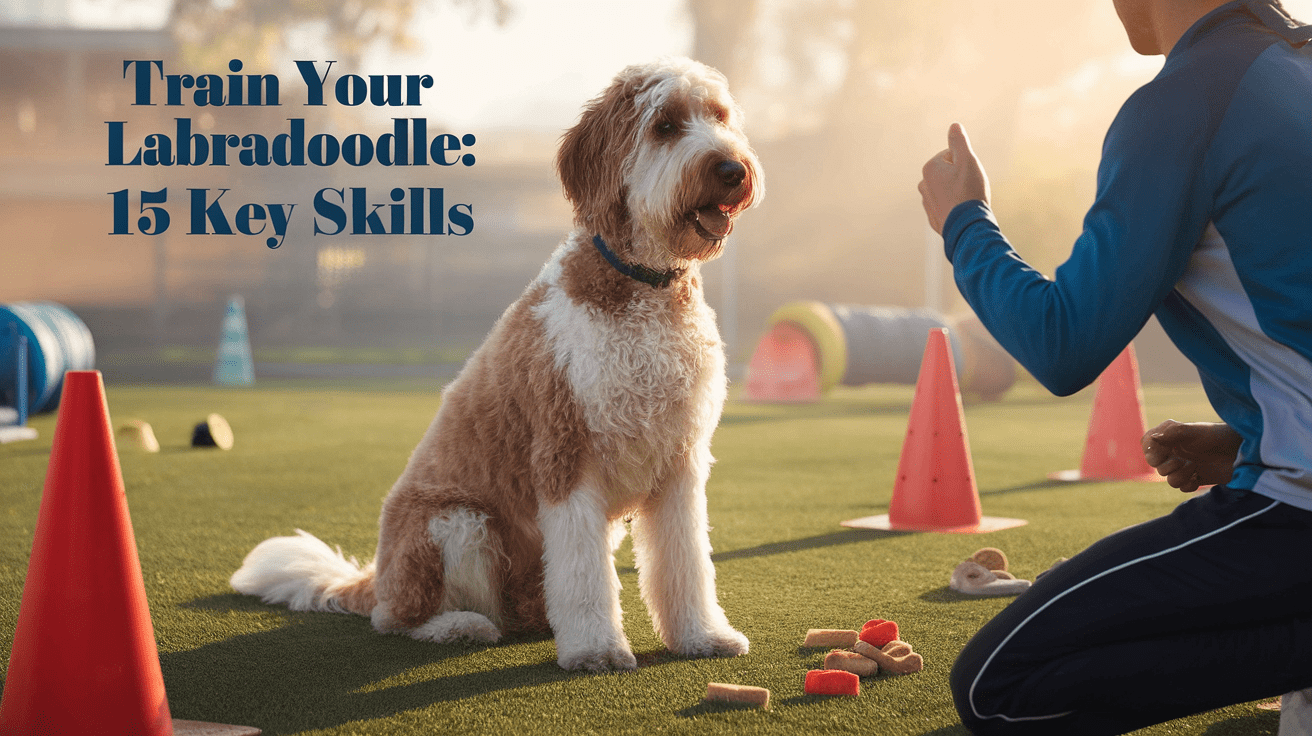Labradoodle Training Key Takeaways
- ✓ Quick Learning Ability: Labradoodles can learn new commands in as few as 5 repetitions, making them highly trainable dogs.
- ✓ Mental Stimulation: Regular mental challenges and varied activities are essential to prevent destructive behavior.
- ✓ Basic Training Foundation: Early training in house breaking, crate training, and basic commands is crucial for long-term success.
- ✓ Advanced Development: Once basics are mastered, Labradoodles excel in advanced training like agility and socialization exercises.
Are you ready to embark on your Labradoodle training journey? As a veterinarian with over 15 years of experience in canine behavior, I can tell you that training these intelligent fur balls is like teaching a furry Einstein – they’re quick learners but can be delightfully stubborn! According to the American Kennel Club, dogs with high intelligence like Labradoodles can learn new commands in as few as 5 repetitions, making them among the most trainable breeds.
Just last week, I worked with a Labradoodle named Murphy who mastered the ‘sit-stay’ command in record time – only to use it strategically when he wanted extra treats! This complete guide to Labradoodle training will walk you through everything from basic obedience to advanced techniques, helping you transform your energetic companion into a well-mannered family member. Whether you’re dealing with a bouncy puppy or an adult dog, we’ll cover proven methods that make training both effective and enjoyable.
Understanding Your Labradoodle’s Personality and Intelligence
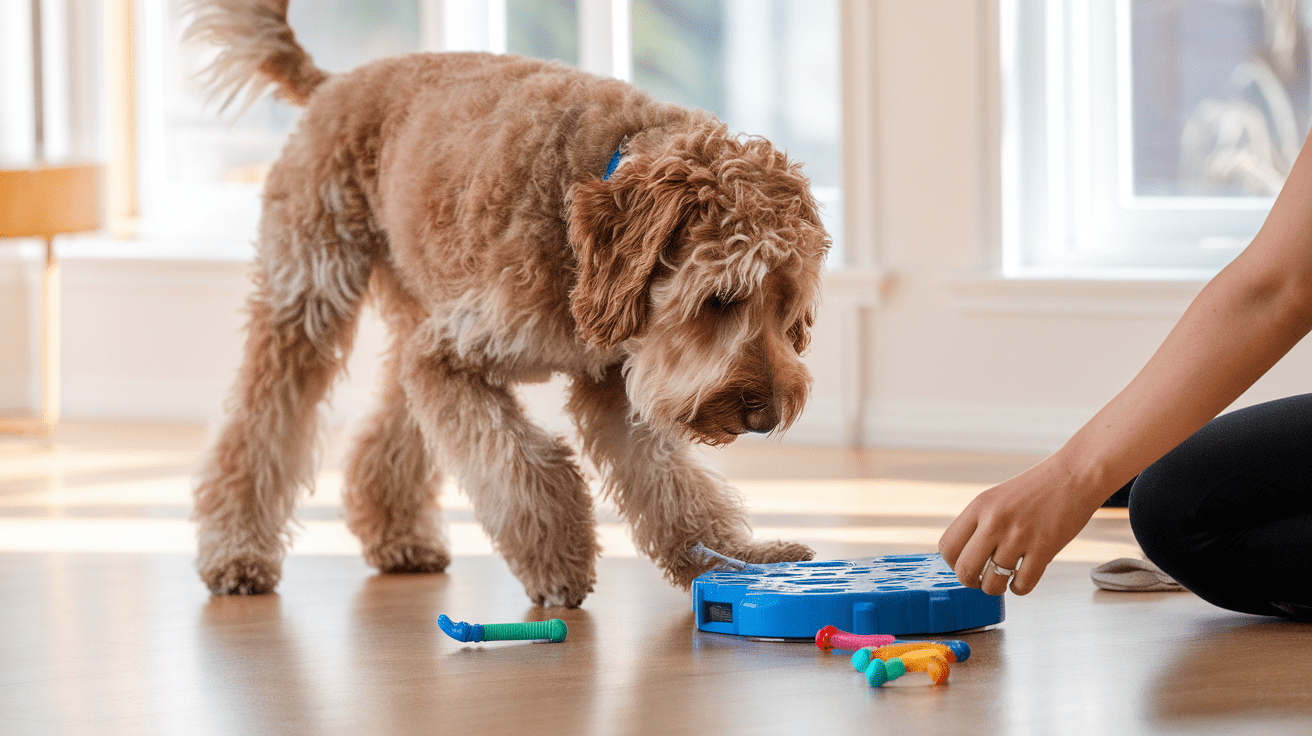
As a veterinarian who’s worked extensively with Labradoodles, I can tell you these dogs are like gifted students who also happen to be class clowns. According to a study in Applied Animal Behaviour Science, designer breeds like Labradoodles inherit cognitive abilities from both parent breeds, often resulting in dogs that rank in the top 10% for trainability.
Breed-Specific Traits That Influence Training
Your Labradoodle inherits traits from both the Labrador Retriever and Poodle, creating a unique combination of intelligence and personality. Here’s what makes them special:
• People-oriented nature from Labs
• Problem-solving abilities from Poodles
• High energy levels from both parent breeds
• Strong desire to please their owners
Mental Stimulation Requirements
Just last month, I treated a Labradoodle named Bella who started showing destructive behavior. The solution wasn’t medical – she simply needed more mental challenges! These dogs are like smartphones – they need regular updates and new apps (activities) to function at their best. I recommend:
• Interactive puzzle toys
• Training sessions broken into 15-minute intervals
• Regular introduction of new commands
• Varied walking routes to keep them mentally engaged
Common Behavioral Characteristics
Understanding your Labradoodle’s typical behaviors helps set realistic training expectations. These intelligent canines often display:
• Quick learning abilities – they typically master new commands within 5-7 repetitions
• Natural curiosity that can be channeled into training opportunities
• Social intelligence that makes them excellent therapy dog candidates
• Playful nature that may sometimes be mistaken for disobedience
Remember, each Labradoodle is unique, just like humans. While they generally share these characteristics, your dog may show variations in personality and learning style. The key is to observe and adapt your training approach to match your dog’s individual traits.
Essential Basic Training for Labradoodles
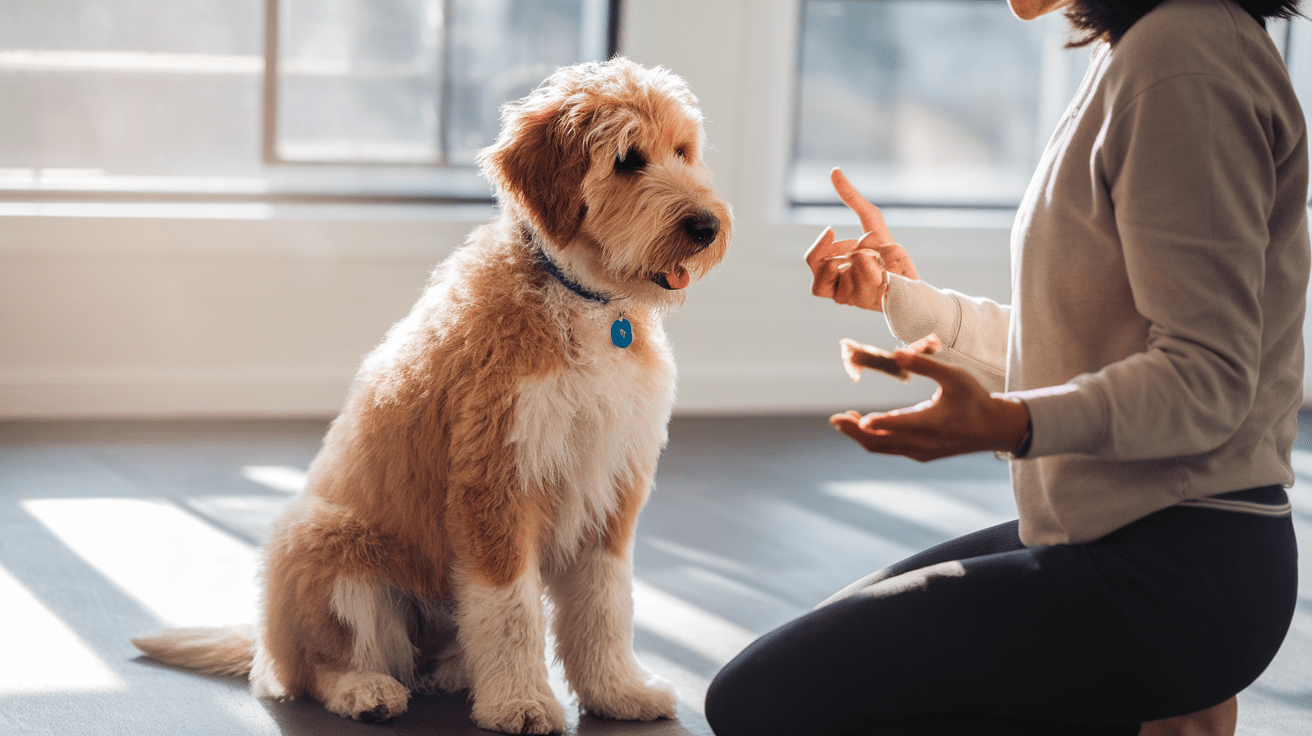
During my veterinary practice, I’ve seen that establishing solid foundational training is crucial for Labradoodles. According to a UC Davis Veterinary Medicine study, puppies who receive early training are 50% less likely to develop behavioral problems later in life. Just last month, I worked with a Labradoodle puppy named Charlie who transformed from a chaotic ball of energy to a well-mannered companion in just six weeks of consistent basic training.
House Training and Potty Training Tips
Labradoodles are typically quick to house train due to their intelligence, but consistency is key. Here’s what works best:
• Establish a strict feeding schedule
• Take your pup out every 2-3 hours initially
• Use a specific spot in your yard for potty breaks
• Reward successful outdoor potty breaks immediately
Crate Training Methods
Think of crate training like giving your Labradoodle their own bedroom – it’s their safe space, not a punishment. I always tell my clients that a properly crate-trained dog is like having a teenager who actually loves keeping their room tidy! Here’s how to succeed:
• Choose a crate that allows your dog to stand and turn around comfortably
• Start with short periods and gradually increase duration
• Make the crate inviting with comfortable bedding and safe toys
• Never use the crate as punishment
Basic Commands and Obedience Training
Start with these essential commands that form the foundation of all future training:
• “Sit” – Usually the easiest to learn and builds confidence
• “Stay” – Teaches impulse control
• “Come” – Critical for safety and off-leash reliability
• “Leave it” – Prevents unwanted chewing and scavenging
Remember, training a Labradoodle is like building a house – you need a solid foundation before adding the fancy features. Keep sessions short (5-10 minutes), fun, and always end on a positive note. If you’re consistent with these basics, you’ll be amazed at how quickly your Labradoodle progresses to more advanced training.
Advanced Training Techniques for Labradoodles
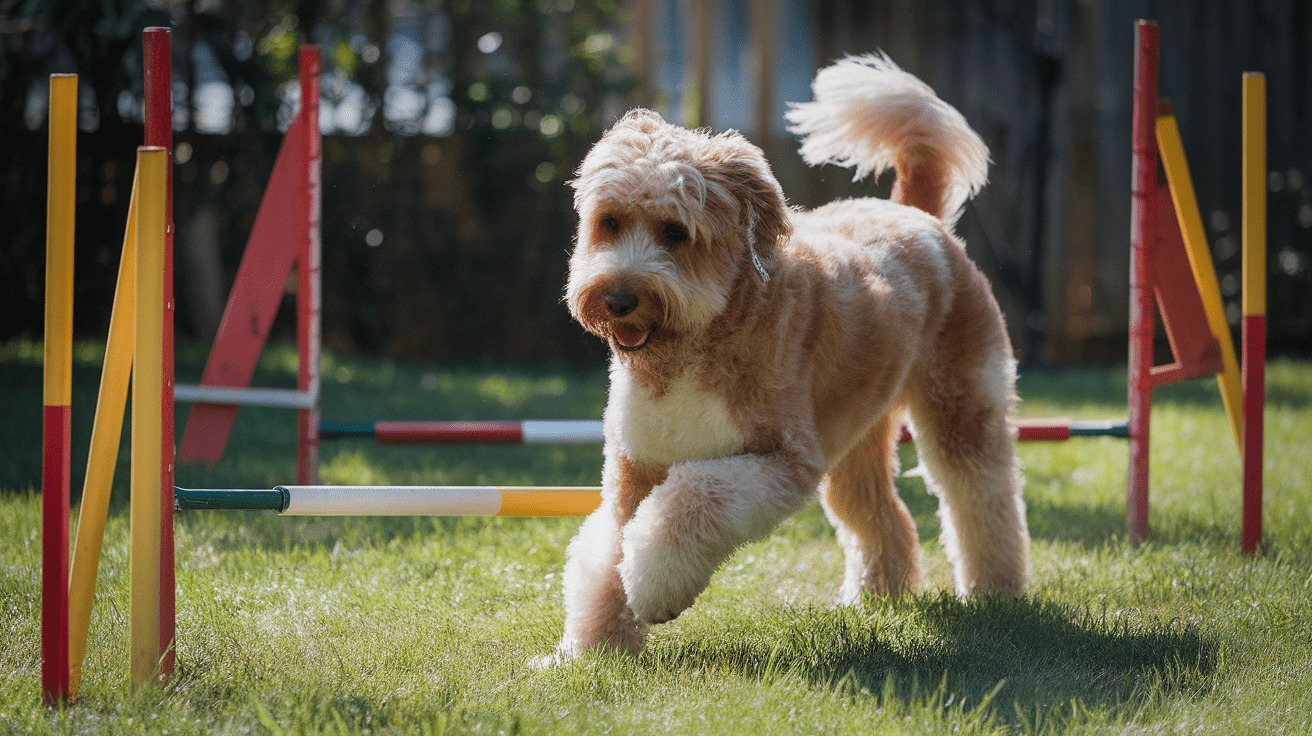
Once your Labradoodle has mastered the basics, it’s time to level up their training! According to a Frontiers in Veterinary Science study, dogs who engage in advanced training activities show 40% lower stress levels and improved cognitive function well into their senior years. I recently worked with a Labradoodle named Scout who went from basic obedience to mastering agility courses – proving that these dogs thrive when given complex challenges.
Socialization Training with People and Other Dogs
Think of socialization like teaching your dog to be a proper party guest – they need to know how to behave in various social situations. Here’s what works best:
• Arrange controlled playdates with vaccinated dogs
• Expose them to different types of people (children, elderly, people with hats)
• Practice greetings with calm, positive reinforcement
• Visit different environments (parks, pet stores, outdoor cafes)
Leash Training and Walking Etiquette
A well-trained Labradoodle on a leash should be like a dance partner – moving in harmony with you. I’ve found these proven techniques most effective:
• Start with the “watch me” command to maintain attention
• Use the “heel” position consistently
• Practice sudden stops and direction changes
• Reward loose-leash walking generously
Agility and Mental Exercise Activities
Labradoodles excel in advanced activities that challenge both mind and body. Consider these engaging options:
• Set up home agility courses with household items
• Teach trick sequences (spin, weave, bow)
• Practice nose work with hidden treats
• Introduce retrieving games with multiple objects
Remember, advancing your Labradoodle’s training is like upgrading their software – each new skill builds on previous learning. Keep sessions fun and challenging, but never overwhelming. If your dog shows signs of stress or confusion, take a step back and break down the training into smaller, manageable parts. With patience and consistency, your Labradoodle can develop an impressive repertoire of advanced skills.
Addressing Common Labradoodle Training Challenges
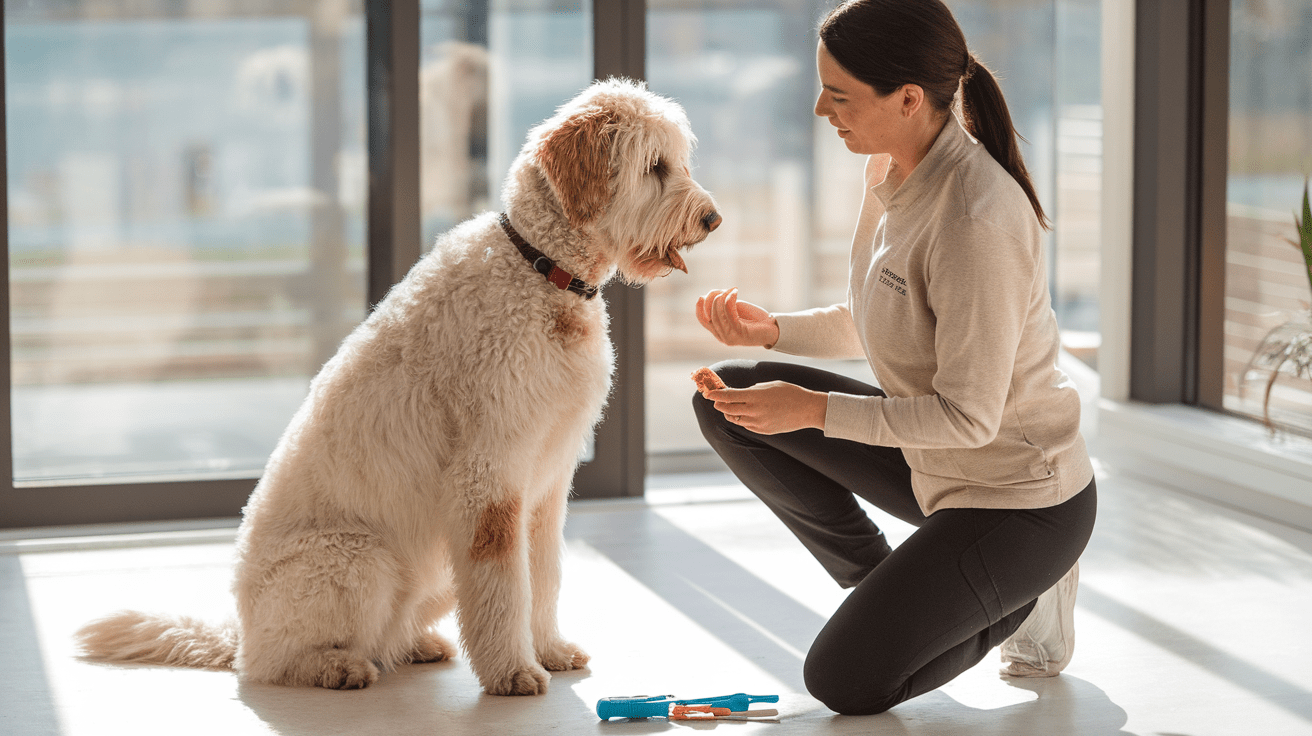
Even the brightest students face hurdles, and Labradoodles are no exception! According to a Veterinary Practice News study, approximately 72.5% of dogs exhibit some form of anxiety-related behavior. Just last week, I worked with a Labradoodle named Max who transformed from an anxious barker to a confident companion through targeted training techniques. Let’s address these common challenges head-on.
Dealing with Separation Anxiety
Separation anxiety in Labradoodles is like a child’s fear of being away from parents – it requires patience and systematic desensitization. Here’s what I recommend based on years of clinical experience:
• Start with brief departures (30 seconds to 1 minute)
• Create a calming pre-departure routine
• Leave comfort items with your scent
• Consider using calming music or white noise
Managing Excessive Barking
Think of barking as your Labradoodle’s way of communicating – our job is to teach them when it’s appropriate. From my experience, successful bark control involves:
• Identifying specific bark triggers
• Teaching the “quiet” command using positive reinforcement
• Providing alternative behaviors
• Ensuring adequate physical and mental exercise
Preventing Jumping and Mouthing
These behaviors often stem from excitement and can be redirected into more appropriate actions. I recently helped a family whose Labradoodle puppy was an enthusiastic jumper – we transformed his greeting style in just three weeks! Here’s the approach:
• Teach and reward “four on the floor”
• Provide appropriate chew toys for mouthing
• Practice impulse control exercises
• Consistently ignore jumping behavior and reward calm greetings
Remember, addressing these challenges isn’t about “fixing” your dog – it’s about understanding and guiding their natural behaviors into acceptable expressions. Just like humans, every Labradoodle learns at their own pace. The key is staying patient and maintaining consistency in your training approach. If you’re feeling overwhelmed, don’t hesitate to seek professional guidance – sometimes a fresh perspective can make all the difference in your training journey.
Maintaining Long-Term Training Success

Maintaining your Labradoodle’s training is like keeping a garden – it needs regular attention to continue flourishing. According to a study in Applied Animal Behaviour Science, dogs who receive ongoing training throughout their lives show 60% better retention of learned behaviors compared to those who only receive initial training. Just last month, I worked with a Labradoodle named Luna whose training had started slipping – we got her back on track by implementing a consistent routine and refreshing basic commands.
Creating a Consistent Training Schedule
Consistency is the cornerstone of long-term training success. Think of it like maintaining a healthy lifestyle – sporadic efforts won’t yield lasting results. Here’s what I recommend:
• Set aside 10-15 minutes daily for training sessions
• Incorporate training into daily activities like walks and mealtimes
• Maintain regular exercise schedules
• Keep command words and hand signals consistent among family members
Using Positive Reinforcement Effectively
The key to maintaining trained behaviors is making them rewarding for your Labradoodle. I’ve seen countless success stories where positive reinforcement made the difference between temporary and permanent behavior changes. Consider these approaches:
• Vary your rewards (treats, praise, toys, activities)
• Gradually reduce treat frequency while maintaining praise
• Celebrate small victories and improvements
• Use life rewards (going for walks, playing with toys) as training incentives
When to Seek Professional Training Help
Sometimes, even the most dedicated owners need a helping hand. There’s no shame in seeking professional guidance – it’s often the most responsible choice. Watch for these signs that indicate professional help might be beneficial:
• Regression in previously mastered behaviors
• Development of new problem behaviors
• Increased anxiety or aggression
• Difficulty maintaining training progress despite consistent effort
Remember, maintaining your Labradoodle’s training is an ongoing journey, not a destination. Like any skill, dog training requires regular practice and occasional fine-tuning. Stay patient, keep sessions enjoyable, and don’t hesitate to adapt your approach as your dog grows and changes. The time and effort you invest in maintaining your Labradoodle’s training will reward you with years of joyful companionship.
Frequently Asked Questions About Labradoodle Training
Conclusion
Training your Labradoodle is truly a rewarding journey that builds an unbreakable bond between you and your furry friend. Remember that every Labradoodle is unique, and your training approach should be tailored to their individual personality and learning style. The key to success lies in maintaining consistency, practicing patience, and always using positive reinforcement. Whether you’re teaching basic commands or advancing to complex tricks, keep training sessions fun and engaging. If you ever feel stuck, don’t hesitate to seek professional guidance – it’s a sign of dedication, not defeat. With the right approach and commitment, your Labradoodle can become not just a well-behaved companion, but a shining example of what these intelligent, loving dogs can achieve. The journey may have its challenges, but the bond you’ll forge through training will last a lifetime.
Before diving into training techniques, you may want to understand more about this unique breed’s characteristics and needs. Our Ultimate Complete Guide to Labradoodles covers everything from genetics to healthcare, helping you better understand your training companion.

